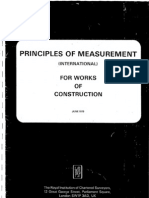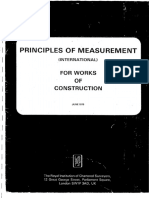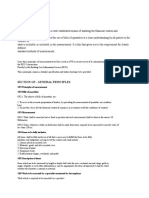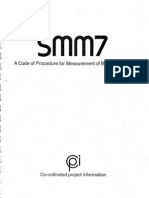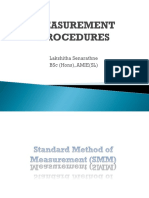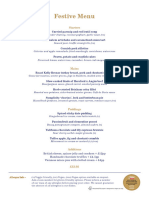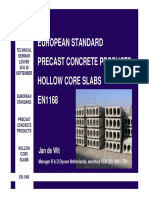0 ratings0% found this document useful (0 votes)
20 views25 pagesPOMI For Structures Placement Analysis Management
The document outlines the Principles of Measurement for construction works, established by The Royal Institution of Chartered Surveyors to standardize the preparation of bills of quantities and improve financial control in construction projects. It emphasizes the need for flexibility to accommodate varying practices across different countries and contracts. The principles cover various aspects of measurement, including the description of items, inclusivity of costs, and specific requirements for different types of work.
Uploaded by
Shamik BiswasCopyright
© © All Rights Reserved
We take content rights seriously. If you suspect this is your content, claim it here.
Available Formats
Download as PDF or read online on Scribd
0 ratings0% found this document useful (0 votes)
20 views25 pagesPOMI For Structures Placement Analysis Management
The document outlines the Principles of Measurement for construction works, established by The Royal Institution of Chartered Surveyors to standardize the preparation of bills of quantities and improve financial control in construction projects. It emphasizes the need for flexibility to accommodate varying practices across different countries and contracts. The principles cover various aspects of measurement, including the description of items, inclusivity of costs, and specific requirements for different types of work.
Uploaded by
Shamik BiswasCopyright
© © All Rights Reserved
We take content rights seriously. If you suspect this is your content, claim it here.
Available Formats
Download as PDF or read online on Scribd
You are on page 1/ 25
yeu
0% [10] wees
PRINCIPLES OF MEASUREMENT
(INTERNATIONAL)
FOR WORKS
OF
CONSTRUCTION
JUNE 1979
© The Royal institution of Charteres Surveyors, 12 Great George Steet, Parliament Squate, London SW1P 3AD, UK
Foreword
Bills of quantities as an aid to the financial control and Management of building contracts have
developed in the United Kingdom over a considerable period of time and, because of widely varying.
practices and consequent disputes, a set of principles of measurement was first established on a
national basis in 1922. Since then, amendments have been made to reflect the growth of experience
and developments in construction practice,
In recent years there has been an expansion of construction throughout the world, much of it in
hitherto undeveloped areas. This has involved a variety of nationalities of contracting companies and
Consultancies in the construction process, which in turn has created difficulties in the administration
of contracts. Projects are becoming larger; reductions are sought in the pre-tender period; an
increasing number of contract documents require bills of quantities but provide no framework within
which they can be prepared, nor a commonly agreed basis of measurement.
In consequence The Royal Institution of Chartered Surveyors appointed a committee to prepare
principles of measurement suitable for use where existing rules are inappropriate or where no rules
exist. However, to permit their proper use, the principles do require that a detailed specification and
tender drawings be provided. The Institution also recognises that circumstances vary considerably
from country to country, and from contract to contract, and that the principles therefore need to be
flexible to accommodate variations in practice and techniques.
The principles will be reviewed after a period of use and any comments should be sent to the
Sectetary-General of the RICS at 12 Great George Street, Parliament Square, London SWIP 3AD.
Jam grateful 19 Michae! Rainbird ARICS, who co-ordinated the preparation of the principles, andto
Alan Charter FRICS, James Diebel FRICS, Derek Lawrence FRICS and Michael Pagulatos ARICS
for having produced @ document which the Institution hopes will make a valuable contribution to the
administration, financial control and execution of construction projects throughout the world.
C2. gl
PRESIDENT
AEE Ete are rege
Comtents
SECTION GP — GENERAL PRINCIPLES
Pi
GP2
GP3
GP4
GPs
GP6
GP7
GPs
GPS.
GPI0
Al
AD
a3
Aa
AS
AS
AD
AS
ad
SECTION A — GENERAL REQUIREMENTS
Principles of measurement
Bills of quantities.
Measurement ....
Items to be fully inclush
Description of items
Work to be executed bya specialist nominated by the empioyer . :
Goods, materials or services 1o be provided by a merchant or tradesman
nominated by the employer .......
Work to be executed by a government jor public authori
Dayworks....
Contingencies.
Conditions of comtract ...-...e2045
Specification . satiety
Restrictions 7
Contracior’s administrative itrangements. arty
Consiructional plam
Employer's facilities .,
Contractor's facilities <..*
Temporary works
Sundry items... 01.
Db hbo
SECTION B — SITE WORK
Biz
Bi
Bla
BIS
BiG
BI7
Bs
BI9
B20
BQ
BR
B23
BM
BIS
B26
‘exploration generally .
wether i
Boreholes (including pumping test wells)
Site preparation . : 7
Demolitions and alterations
Shoring......
Underpinning: tht
Earthworks generally |.
Excavation .
Dredging.
Disposal =.
Filling ..
Piling generaily
Driven pil
8
Sheet piling...
Performance designed piling -
Testing piling ...-.. 4.2.46
Underground drainage ©.
Paving and surfacing...
Fencing......
Landscaping. -
Railway work
Tunnel excavation .
Tunnel linings
Tunnel support and stabilisation
SECTION C— CONCRETE WORK
a
a
4
cs
co
a
Generally .
Poured concrete...
Reinforcement .
Shuttering. 2.000221
Precast concrete...
Prestressed concrete
Sundries .........1
SECTION D — MASONRY
DI
D2
D3
Da
DS
SECTIONE — METALWORK
EL
ER
ER
Generally:
Walls and piers.
Sills, ete, a
Reinforcement. <2... :
Sundries 7
Generally ..
Structural metalwork |
Non-structural metalwork
SECTION F — WOODWORK
Fl Generally
F2 Structural timbers <2.
F3 Boarding and flooring.
F4 Grounds and battens
FS Framework.........
6 Finishings and fittings.
F7 Composite tems .......
F8 Sundry items
F9 Metalwork
FIO Ironmongery 7 7
SECTION G — | THERMAL AND MOISTURE PROTECTION
GI Generally ebhtdsthdalt 7 cette
G2 Coverings andlinings 122.2010.) : Teas:
G3 Damp-proof courses eeneey
G4 Insulation. 4
SECTION H — DOORS AND WINDOWS
HI Doors...
H2-— Windows.) 7
H3 Screens.
Hé Ironmongery
HS Glass...
H6 Patent glazing
SECTION J ~ FINISHES
JD Generally’. 2...2.. 0.
32 Backgrounds...)
33 Finishings... 7
34° Sundries’. ne
JS Suspended ceilings: 2111
36 Decorations «2.1!
37 Signwriting
SECTION K — ACCESSORIES
K1— Generally...
K2 Partitions ..
SECTION 1 — EQUIPMENT
LI Generally”.
SECTION M — FURNISHINGS
M1 Generally . tele
M2 Curtain track...
SECTION N — SPECIAL COM
NI Generally .
N2_— Enclosures -:
N3._ Installations -
SECTION P — CONVEYING SYSTEMS
PL Generally -...0.. 2.44 “4 setteeeeeeee dT
P2 Sundries et daetrdy.
P3 Work incidental to conveying systems... Daa
SECTION Q— MECHANICAL ENGINEERING INSTALLATIONS
SI Generally
Pipework a1
8 Beswen
Equipment |.
QS Automatic controls»;
0
7
18
eeeeee!
D8
Connections to supply mains «1.2. 11.2. 1) 18
Q7 Insulation, including linings and protective coverings S18
QB Sundri Rest taet 18
Q9 Work incidental to mechanical engineering installations
SECTION R ~ ELECTRICAL ENGINEERING INSTALLATIONS
Generally
RO Maman’:
R3—Sub-main circuits,
18
19
ag
119
R4 Final sub-circuits a 19.
RS Accessories : Seen
R6 Control gear.
R7— Equipment 00.22.) atria teeta :
RE Connections to supply mains...
R9 Sundries ....
RIO. Work incidental to electrical engineering installations.
APPENDIX
Amendments to principles of measurement
SECTION GP — GENERAL PRINCIPLES
GPI
Gh!
GP1.2
P13
GP2
GP2.4
GP2.2
GP2.3
P24
GP3
GP3.1
GP3.2
GP3.3
GP3.4
GP3.5
GPa
GP4.1
GPS
GPS.
OP5.2
OPS.3
OPS.4
Principles of messurement
‘These principles of measurement provide 2 uniform basis for measuring bills of quantities
for works of construction. More detailed information than is required by this document may
be given to define the precise nature of work or the circumstances under which it is to be
carried oun.
Amendments to these principles of measurement for use in 2 particular locality or adopted
for work not envisaged by this document shall be stated: an appendix is provided for such
amendments to be recorded.
‘These principles of measurement may be applied equally to the measurement of proposed
works and of compleied works.
Bills of quar
ies
The objects of bills of quantities are:
1. To assist in the accurale preparation of tenders, by providing for measurement of
Quantities ona uniform basis
2. To provide a basis for the financial control of a project, in accordance with the
conditions of contract.
Bills of quantities shall describe and represent the works to be carried out: work which
cannot be measured accurately shall be described as approximate or given in bills of
approximate quantities.
Conditions of contract, drawings and specifications shall be provided with the bills of
quantities.
The section headings and classifications do not impose restrictions upon the format and
presentation of bills of quantities,
‘Measurement
Work shall be measured net as fixed in position and each measurement shall be taken to the
nearest 10 millimetres; this principle shall not apply to dimensions stated in descriptions.
‘Unless: otherwise:statedy no.deduction shall be made from’items required to be measured by
Regn eNOE NaN LOOM!
Minimum deductions of voids shall refer only to voids within the edges of measured areas;
voids which are at the edges of measured areas shall always be deducted, irrespective of size.
These principles of measurement may be used with other units of measurement but the
particular amendments shall be stated.
Notwithstanding these principles of measurement, a separate minor building or structure
may be enumerated.
Items to be fully inclusive
Unless otherwise stated, all items shall be fully inclusive of all that is necessary to fulfill the
Jiabilties and obligations arising out of the contract and shell include:
1. Labour and all associated costs
2. Materials, goods and all associated costs
3. Provision’of plant,
4. Temporary works
$. Establishment charges, overheads and profit.
Description of items
Items which are required 10 be enumerated, or for which an item is required, shall be fully
described.
Jrems which are to be measured by length or depth shall state the cross-sectional size and
shape, girth or ranges of girths or such other information as may be appropriate; for items of
Pipework it shall be stated whether the diameter is internal or external.
Items which are to be measured by area shall state the thickness or such other information as
may be appropriate.
Items which are to be measured by weight shall state the material thickness and unit weight if
appropriate (for example, ductwork),
Principles of
measurement
Bills of quantities
Measurement
ems to be fully
jnciuuve
Description of items
Description of items
Aecentnuee)
Work to be
ceneuted bs 8
Speci no
Ddovthe employer
Goods, materials
services to be
Drovided by =
merchant oF
Work 10 be
rxecuted BY 8
fovernmest or
public authority
Dayworks
‘OPS.5
GPS.6
GP6
GP6.1
GP6.2
GP7
P71
oP7.2
GPs
GPE.
Pa.
GP9.1
GP9.2
GP9.3
GP9.4
GP9.s
GP9.6
GP9.7
Notwithstanding these principles of measurement, proprietary’ items may be measured in a
manner appropriate to the manufacturer's tariff oF customary practice
The description of items in bills of quantities may refer to other documems or drawings and
any reference to such information shall be understood to fulfill any requirement of these
Principles of measurement; alternatively, reference may be made to published information.
‘Work to be executed by a speci
t nominated by the employer
Unless otherwise required by the conditions of contract, work which is required to be
ecuted BY a specialist nominated by the employer shall be given as a sum: such sum shall be
palere ‘of contractor's profit andjin €ach-casé an itéin shall be given for the addition of
profi:
‘An item shall be given in each case for assistance by the contract
which shall include:
Use of contractor's administrative arrangements
Use of constructional plant
Use of contractor's facilities
4. Use of temporary works
5. Space for specialist's offices and stores
6. Clearing away rubbish
7. Scaffolding required by the specialist, siving particulars
8. Unloading, distributing, hoisting and placing in position items of plant, machinery or
the lke, giving particulars
Goods, materi
employer
Is or services to be provided by a merchant or tradesman nominated by the
Unless otherwise required by the conditions of contract, goods, materials or services which
are required to be provided by a merchant or tradesman nominated by the employer shall be
given as a sum; such sum shall be exclusive of contractor's profit and in each case an item
shall be given for the addition of profit
Fixing goods and materials shall be given in accordance with the relevant clauses in these
Principles of measurement; fixing shall be understood to include unloading, storing,
distributing and hoisting the goods and materials. Particulars shall be given of any
equirements forthe contractor to arrange for delivery or pay any costs of conveying goods
or materials.
Work 10 be executed by a government or public authority
Unless otherwise required by the conditions of contract, work which may only be carried out
by a government or public authority shall be given as a sum; such sum shall be exclusive of
ontractor’s profit and in each case an item shall be given for the addition of profit.
Aa figm shall be given in each case for asistance by the contractor as described in clause
6.2.
Dayworks
The cost of labour in dayworks shall be given as a sum; alternatively, a schedule of the
different categories of labour may be given containing @ provisional quantity of hours for
each category.
The cost of labour included in a sum or schedule shall include wages, bonuses and all
allowances paid to operatives directly engaged on dayworks (including those operating
‘mechanical plant and transport) in accordance with the appropriate employment agreement
for, where no such agreement exists, the actual payments made to the work people concerned.
The cost of materials in dayworks shall be given as a sum; alternatively, a schedule may be
given containing a provisional quantity of different materials.
The cost of materials included in a sum or schedule shall be the net invoiced price, including
delivery to site
‘The cost of constructional plant employed exclusively in dayworks shall be given as a sum;
akernatively, a schedule of the different categories of plant may be given containing
provisional quantity of hours, or such other period of time as may be appropriate, for each
category.
‘The cost of constructional plant included in a sum or schedule shall include fuel, consumable
stores, repairs, maintenance and insurance of plant
An item shall be given for the addition of establishment charges, overheads and profit to
each of the sums oF schedules of labour, materials or plant
GP9.8 Establishment charges, overheads and profit shall include:
Costs related to the employment of labour
Costs related to the storage of materials, including handling and waste in storage
Contractor's administrative arrangements
‘Constructional plant, except plant employed exclusively on dayworks
Contractor's facilities
Temporary works
Sundry items.
GP10 Contingencies
GP10.1 Unless otherwise required by the conditions of contract, contingencies shall be given as 2
sum; no item shall be given for the addition of profit
SECTION A — GENERAL REQUIREMENTS.
Al Conditions of contract ;
XK
AL1 “A schedule of the clause headings shall be set out in the bills of quantities.
Al.2_-Where there is an appendix to the conditions of contract requiring insertions to be made, a
schedule of the insertions shall be set out in the bills of quantities.
AZ Specification
ALJ Where, the specification contains clauses related to any of the following General
Requirements, the bills of quantities shall make reference to the appropriate clauses.
A3 Restrictions
A3.1 Particulars shall be given of any restrictions, which shall include:
1. Access to and possession or use of the site
2. Limitations of working space
3. Limitations of working hours
4. The maintenance of existing services on, under or over the site
$. The execution or completion of the work in any specific order, sections or phases
6 ems of alike nature.
A4 Contractor's administrative arrangements
A4.1 An item shall be given for contractor's administrative arrangements, which shall include:
1. Site administration
2. Supervision
3. Security
4, Safety, health and welfare of workpeople
5. Transport of workpeople.
AS Constructional plant
AS. Anite shall be given for constructional plant, which shall include:
1. Small plant and tools
2 Scaffolding
3. Cranes and lifting plant
4 Site transport
5.
Plant required for specific trades.
A6 Employer's facilities
A6.1 Particulars shall be given of any facilities required for the employer or the employer's
representatives, which shall include:
1. Temporary accommodation (for example, offices, laboratories, living accommodation),
including heating, cooling, lighting, furnishing, attendance or related facilities
Telephones, including costs of calls; alternatively, the cost of calls may be given as a sum
Vehicles
Attendance of staff (for example, drivers, laboratory assistants)
Equipment (for example, survey or laboratory equipment)
5. Special requirements for programmes or progress charts
Any other facilities (for example, progress photographs, signboards),
Darworks,
continued)
Contingencies
Conditions of
‘Specification
Restrictions
Contracior's
sdmiaistralve
arrangement
Constructions! plant
Exaployers fnclites
Temporary works
Sadr ems
Site exploration
generally
Trial holes
Borehotes dncudi
ormplng test wells)
Ar
Contractor's facilities
7.1 Anitem shall be given for facilities required by the contractor, which shall include:
1, Accommodation and buildings, including offices, laboratories, compounds, stores,
messrooms and living accommodation
2. Temporary fencing, including hoardings, screens, roofs and guardrails
3. Temporary roads, including hardstandings and crossings
4, Water for the works; particulars shall be given if water will be supplied to the contractor
‘5. Lighting and power for the works; particulars shall be given if current will be supplied 10
the contractor
6. Temporary telephones
A7.2_ Particulars shall be given where the nature or extent of the facilities is not ai the discretion of
the contractor.
AB
AB.1__Anitem shall be given for temporary works, which shall include
1. Traffic diversion
2. Access roads
3 Bridges
4, Cofferdams
$) Pumping
ei
‘Compressed air for tunnelling.
A8.2 Particulars shall be given where the nature or extent of the temporary works is not at the
discretion of the contractor.
AD ‘Sundry items
A9.1__ Anitem shall be given for sundry items, which shall include:
1. Testing of materials
2. Testing of the works
3. Protecting the works from inclement weather
4, Removing rubbish, protective casings and coverings and cleaning the works at
completion
‘5. Traffic regulations
6. Maintenance of public and private roads
7, Drying the works
8. Control of noise and pollution
9. All statutory obligations,
A9.2 Particulars shall be given where the nature or extent of the sundry items is not at the
discretion of the contractor.
SECTION B — SITE WORK
BI Site exploration generally
Bi. Keeping records of site observations, site tests and laboratory tests shall be given as an item.
B1.2 Samples, site observations, site tests, laboratory tests and analyses shall be given as an item.
B13 Providing reports shall be given as an item.
B2 Trial holes
B2.1 Excavating trial holes shall be measured by depth, taken along the centre line, stating the
number and the maximum depth below commencing level.
B22 pean ‘support which is not at the discretion of the contractor shall be measured by
lepth.
B3_—_Boreholes (including pumping test wells)
B31 Driving boreholes shall be measured by depth, taken along the centre line, stating the
ae and thgsmaximum depth below commencing level; raking boreholes shal! be so
lescribed.
B3.2 Lining which is not at the discretion of the contractor shal] be measured by depth.
B3.3_ Cappings shall be enumerated.
Ba
Ba.t
B42
B43
BS.2
BS.3
BS.4
BS.S
B6
BG6.1
B6.2
B63
B64
BT
BI1
B12
BI
BIS
BIS
BS
BB.1
B82
88.3
B84
B.S
BB.
Site preparation
Removing isolated trees shall be enumerated
Removing hedges shall be measured by length
Site clearance, which shall include removing vegetation, undergrowth, bushes, hedges, trees
for the like, shall be measured by area,
Demolitions and alterations
‘The location of each item shall be given. Unless otherwise stated, old materials shall be
uundersiood to become the property of the contracior and shall be cleared away; old materials
required to remain the property of the employer shall be so described
Removing individual fittings, fixtures, engineering installations or the like from an existing
structure shall each be given as an item
Demolishing individual structures (or part thereof) shall each be given as an item;
altematively, demolishing all structures on a site may be given as an item.
Cutting openings in existing structures and alterations 10 existing structures shall each be
given as an item; making good all work damaged shall be understood to be included.
‘Temporary screens and roofs shall be given as an item.
Shoring
Shoring incidental to demolitions and alterations, together with clearing away and making
00d all work damaged, shall be understood to he included.
Shoring (other than that incidental to demolitions and alterations) shall be given as an item,
stating the location; clearing away and making good all work damaged shall be understood
tobe included.
Particulars shall be given where the design of the shoring is not at the discretion of the
contractor,
Shoring which is required by the specification to be left in position shall be so described.
Underpinning
Work in underpinning shal! be given under an appropriaté heading, stating the location.
‘Unless otherwise stated, work shall be measured in accordance with the appropriate sections
of this document.
‘Temporary suppor shal be given as an item: particulars sal be given where the design of
the temporary support is not at the discretion of the contractor.
Excavation shall be measured by volume, taken to the outside line of the projecting
foundations or to the outside line of the new foundations (whichever is the greater),
classified as follows:
1. Excavation in preliminary trenches down to the base of the existing foundations
2. Excavation below the base of the existing foundations.
‘Cutting away projecting foundations shall be measured by length.
Earthworks generally
Any information available concen
with the bills of quantities
The quantities for excavation, dredging or eee shall be understood to be the bulk
before excavation, and no allowance shall be made for any working space or subsequent
variation in bulk; existing voids shall be deducted,
Multiple handling of materials and transporting about the site shall be understood to be
included; multiple handling which is required by the specification shall be so described in the
item of disposal.
Earthwork support shall be given as an item.
Excavation in rock shall be so described; alternatively, it may be measured as extra over
excavation (that is, the volume of rock shall be measured but no deduction shall be made
from the volume of excavation in which the rock occurs),
i the nature of the ground and strata shall be provided
For the purposes of measurement rock is defined as any material met with which is of such
size or position that, in the opinion of the employer's representative, it can only be removed
by means of wedges, special plant or explosives.
Sie preparation
Demoltions and
aeration
Shoring
Underpinning
Eartbworks
Dredging
Disposal
Fitiog
Ping generally
Deven piling
BS
B9.1
B9.2
B93
B10
Bi0.1
BI
Bia
Biz
BI2t
BIS
BiB.)
BI3.2
BI3.3
Bis
Bi4.1
B14.2
Bi43
Bi44
Excavation
Unless otherwise stated, excavation shail be measured by volume as the void which is to be
Occupied by the permanent construction, or vertically above any part of the permanent
construction, classified as follows:
1. Oversite excavation 10 remove top soil, stating the average depth
2. Excavation to reduce levels
3. Excavation in cuttings
4. Basement excavation
5. Trench excavation 10 receive foundations, which shall include pile eaps and ground
ams
&. Pit excevation to receive foundation bases, stating the number
7. Excavation for diaphragm walls, stating the width of the permanent construction and.
the type of support Nuid.
Excavation of trenches for service pipes, drain pipes, cables or the like shall each be
measured by length, stating the average depth; disposal and filing shal! be understood to be
included.
For excavation in tunnelling see clause B24.
Dredging
Dredging shall be measured by volume, stating the location and limits; unless otherwise
stated, measurement shall be understood to be taken from soundings,
Disposal
Disposal of material arising from excavation, dredging or tunnelling shall be measured by
volume as equal to the volume of excavation, dredging or tunnelling and each shall be
classified as follows:
1. Backfilled into excavation
2. Backfilled in making up levels
3. Backfilled oversite to make up levels, giving details of special contouring, embankments
‘or the like
4, Removed, which shall include providing a suitable tip,
Filling
Filling material (other than that arising from excavation, dredging or tunnelling) shall be
measured by volume as equal to the void to be filled, classified as follows:
1. Filled into excavation
2. Filled in making up levels
3. Filled oversite to make up levels, gi
the like.
ng details of special contouring, embankments or
Piling generally
For the purposes of measurement, driven piling shall include timber, precast concrete or
metal piles
Other piling systems (for example, preformed casing with concrete filling) shall be measured
in accordance with the principles for driven piling or bored piling as may be appropriate,
Unless otherwise stated, reinforcement shall be measured in accordance with Section C.
Driven piling
Supplying piles shall be measured by Jength, stating the number; reinforcement shall be given
seperately.
Heads and shoes shall be enumerated.
Driving piles shall be measured by length, taken from the pile point in contact with the
‘ground when pitched to the pile point when driven, stating the number; driving piles on rake
shall be so described.
Cutting off tops of piles and connections for lengthening piles shall be enumerated.
Bis
Bist
BS.2
BIS.3
BIS.4
BIS.6
B16
Bi6.)
B62
B63
B64
B16.S
B16.6
BIT
BIT
BI7.2
B18
BI8.1
Bd
BI9.1
BI9.2
B19.3
BI0.4
B19.
BI9.6
20.1
220.2
B20.3
Bored piling
Boring for piles shall be measured by length, taken from the formation level of the ground to
the bottom of the pile hole, stating the number; the measurement shall include for blind
boring when the pile top is to be below the formation level of the ground.
Boring through rock shall be measured by length as extra over boring for piles (that is, the
length of boring through rock shall be measured but no deduction shall be made from the
total length of boring).
Linings for piles shall be measured by length.
Disposal of material arising from boring shall be measured in accordance with clause BI
Concrete filling shall be measured by volume.
Cutting off tops of piles and forming enlarged bases shall be enumerated
Sheet piling
‘The measurements for sheet piling shall be taken along the centre line.
Supplying sheet piling shall be measured by area, taken as the area when in final position.
Corner piles or the like shall be measured by length,
Driving sheet piling shall be measured by area, taken from the formation level of the ground
to the bottom edge of the sheet piling when driven; strutting and waling and withdrawing
sheet piling shall be understood to be included.
‘Cutting sheet piling shall be measured by length.
‘Sheet piling which is required by the specification to be left in position shall be so described.
Performance designed piling
Performance designe piles sall be enumerated reinforcement and disposal of material
arising from boring shall be understood 10 be included.
Details shall be given when the pile top isto be below the formation level of the ground,
Testing piling
Testing piling, which shall include trial piles and testing working piles, shall be given as an
item,
Underground drainage
Drain pipes shall be measured by length, taken along the centre line over all fittings; drain
pipes within inspection chambers or the like shall be so described and shall be understood 10
Include fixings and supports.
Drain fittings in the length (for example, bends, junctions) shall be enumerated, grouped
together for each size of pipe and described as ‘fittings’.
Drain accessories (for example, gullies, traps) shall be enumerated; concrete surrounds and
additional excavation shall be understood to be included.
Concrete beds and coverings for drain pipes shall each be measured by length, stating the
diameter of the pipe; surrounds 10 vertical pipes shall be so described and shall be
understood to include formwork.
Inspection chambers or the like shall be enumerated; alternatively, they may be measured in
accordance with the relevant sections of this document and given under an appropriate
eading.
‘Connections to existing drains shall be enumerated, subject to clause GP8,
Paving and surfacing
Paving and surfacing shall be measured by area.
Expansion joints and water stops shall be measured by length.
Channels, curbs, edgings or the like shall be measured by length; curved work shall be so
described.
Bored piling
Sheet pling
Performance
‘ssigned piling
‘Testing plo
Underground
ain
Paving and
surtacing
Landscaping
Railway work
‘Tuoeel excavation
Taped! taings
Bu
BL
B22
B23
B24
B22
B22.1
B22.2
B23
822.4
B23
B23.
B23.2
B23.3
B23.4
B23.5
B23.6
B23.7
B23.8
B24
B24,1
B24,2
24.3
B25
B25.1
B25.2
Fencing
Fencing, which shall include posts and supports in the length, shall be measured by length;
excavating pis, disposal and filling shall be understood to be included,
Special posts (for example, gate posts, siraining posts) shall be enumerated; excavating pits,
disposal and filling shall be understood to be included.
Gates, barriers or the like shall be enumerated.
Finishes shall be measured in accordance with Section J.
Landsceping
Cultivating and fertilising ground shall be measured by area.
Soiling, seeding and turfing shall be measured by area.
Hedges shall be measured by length.
Trees and shrubs shall be enumerated,
Railway work
Track, guard rails and conductor rails shall each be measured by length, taken along the
centre line overall fittings; curved work shall be so described.
‘Sleepers and chairs shall be enumerated,
‘Switches and crossings shall be enumerated, classified as follows:
1. Switches and turnouts
2. Diamond crossings
3. Single slip crossings
4. Double slip crossings
5. Other switches and crossings.
Ballast shall be measured by volume, without deduction for track, classified as follows:
1. Bottom ballast, placed before the track is laid
2. Top ballast, placed after the track is lai,
Concrete track foundations shall be measured by length, except that overwidth foundations
for switches and crossings shall be measured by area; reinforcement and shuttering shall be
understood to be included
Bitumen filler to complete rail assemblies shall be measured by length.
Buffer stops, wheel stops or the like shall be enumerated.
Signalling installations shall be measured in accordance with Section L or Section R.
Tunnel excavation
Excavation shall be measured by volume as the void which is to be occupied, including the
volume of permanent linings, grouped as may be appropriate to identify different lengths
and classified as follows:
Straight tunnels
Straight shafts
Curved tunnels
Curved shafts
‘Tapered tunnels
Tapered shafis
Other cavities, which shall include transitions, breakaways and intersections between
shafts and tunnels.
Forward probing shall be measured by length, stating the number of probes.
For disposal see clause B11.
‘Tunnel linings
Poured concrete linings shall be measured by area, stating whether spray or cast concrete,
classified as follows:
J. Primary tining
2. Secondary lining.
Preformed segmental tunnel linings shall be enumerated.
B26
B26.)
B26.2
526.3
826.4
826.5
826.6
a
cn
C12
che
C2
ca
23
a
cal
C32
C33
C34
Tunnel support and stabilisation
Timber supports shall be measured by volume.
Sprayed concrete supports and reinforcement shall be measured by area,
Rock bolts shall be measured by length.
Face packers shall be enumerated.
Metal arch supports shall be measured by weight
Injection of grout materials shall be measured by weight
SECTION C — CONCRETE WORK
Generally
Reinforced poured concrete and plain poured concrete shall each be so described,
Poured concrete required by the specification to be placed, compacted, cured or otherwise
treated in a particular manner shall be so described.
No deduction shall be made for voids Jess than 1.00 m3, nor for the volume of any
reinforcement or structural metal enclosed in the concrete, except that voids caused by boxed
or tubular structural metalwork shall always be deducted.
Unless, otherwise described, horizontal surfaces of concrete shall be understood to be
ramped.
Poured concrete
Unless otherwise stated, poured concrete shall be measured by volume, classified as follows:
4. Foundations, which shall include combined or isolated bases
2. Pile caps, which shall include ground beams
3. Blinding
4, Beds, which shall include roads and footpaths, stating the thickness
5: Suspended slabs, which shall include floors, landings, roofs or the like, stating the
thickness
6. Walls, which shall include attached columns, stating the thickness
7. Columns, which shall include casing to metal stancheons
. Beams (measured below the slab), which shall include lintels and casing to metal beams
9. Staircases, which shall include steps and strings
10. Diaphragm walls
11. Other classifications (for example, tunnel
appropriate.
ings, bridge abutments) as may be
Poured concrete suspended slabs of special construction, including floors, landings, roofs or
the like, shall be measured by area; coffered and troughed slabs shall be so described, giving
details of solid margins or the like,
Where an item is required to be measured by volume and the thickness stated, then items of
differing thickness may be grouped together, provided that the range of the different
thicknesses is stated.
inforcement
‘The weight of bar reinforcement shall be the net weight without addition for rolling margin,
Supports, spacers or tying wire.
Bar reinforcement shall be measured by weight, stating the diameter; bars of differing
diameters shall be given separately,
Fabric reinforcement shall be measured by area, without addition for laps.
Reinforcement shall be given as an item where the detailed design work is the responsibility
of the contractor.
‘Tunnel support and
Generally
Poured concrete
Relaforcement
Shutering
recast concrete
Prestressed concrete
Sundries
ca
cal
C43
C44
cas
4.6
47
C48
C5.
5.2
5.3
5.4
3.8
5.6
rod
C61
6.2
C63
C64
cn
cn2
13
C14
cns
Shuttering
Uniess otherwise stated, shuttering shall be measured by area, taken as the net area in
contact with the finished face of concrete, classified as follows:
|. Soffits; shuttering to soffits of special construction shall be so described
. Sloping soffits, which shall include soffits of staircases
Sloping upper surfaces, which shall include surfaces more than 15° from horizontal
|. Sides of foundations, which shall include bases, pile caps and ground beams
Sides of walls, which shall include attached columns
Returns 10 walls, which shall include ends, projections and reveals of openings or
recesses
. Sides and soffits of beams, which shall include lintels and breaks in soffits; isolated
beams shall be so described
8. Sides and soffits of sloping beams, which shall include lintels and breaks in soffits;
isolated beams shall be so described
9, Sides of columns
10. Staircases, which shall include treads, risers and strings but exclude soffits
11, Other classifications (for example, tunnel linings, bridges, bridge abutments) as may be
appropriate.
Shuttering to edges, which shall include face of curb or upstand or break in upper surface of
floor, shall be measured by length; items of differing height may be grouped together,
provided that the range of different heights is stated.
Grooves, which shall include throats, rebates, chamfers or the like, 2500 mm? sectional area
or over shall be measured by length; grooves less than 2500 mm? sectional area shall be
understood to be included.
Shuttering may be enumerated where it is more appropriate to do so (for example, decorative
Teatures).
Shuttering which is required by the specification to be left in position shall be so described,
Shuttering to curved, conical and spherical surfaces shall each be so described.
‘Shuttering to provide a special finish shall be so described.
Unless otherwise stated, if the volume of concrete has not been deducted, shuttering to the
faces of a void shall be understood to be included.
Precast concrete
Moulds for precast units shall be understood to be included.
Reinforcement shall be measured in accordance with clause C3 and given under an
appropriate heading; alternatively, it may be described in the item,
Floor slabs, partition slabs or the like shall be measured by area.
Lintels, sills, duct covers or the like shall be measured by length; alternatively, duct covers
may be measured by area.
‘Structural units (for example, beams, stanchions, tunnel rings) shall be enumerated.
Padstones, cappings or the like shall be enumerated.
Prestressed concrete
Prestressed concrete work shall be given under an appropriate heading.
Prestressed concrete shall be measured by volume, classified in accordance with clause C2.
Reinforcement shall be measured in accordance with clause C3; supporting steel wires or
cables shal! be measured by weight,
Shuttering shall be measured in accordance with clause C4, stating whether to pre-tensioned
or post-tensioned members.
Sundries
Surfaces finished to falls or cross-falls shall be measured by area.
Surface finishes shall be measured by area, except that tamped finishes shall be understood
tobe included.
Expansion material or the like shall be measured by area.
Designed joints, water stops, cast-in channels or the like shall be measured by length.
Forming sinkings, channels or the like shall be measured by length and, where appropriate,
the item may include additional excavation, hardcore, shuttering and concrete; alternatively,
they may be enumerated,
C16
a7
Fixings, tes, inserts or the like shall be enumerated; alternatively, they may be measured by Sundries
area
Mortices, holes or the like shall be understood to be included.
SECTION D — MASONRY
DI
pil
Di?
D2
D2
D2.2
D3
3.1
3.2
Ds
D41
Ds
DSs.1
Ds.2
Ds.3
Generally
Sloping, battering and curved work shall each be so described. Generally
Reinforced masonry shall be so described.
‘Walls and piers
Walls and piers shall be measured by area, classified as follows: Walls and piers
1. Walls; integral piers shall be measured as walls of combined pier and wall thickness
2. Walls built against other construction
3. Cavity walls measured as a composite item, including skins and cavity; alternatively, the
skins and cavity may each be measured by'area. Closing cavity walls at ends or around
‘openings shall be understood to be included
4, Isolated piers.
Faced or fair faced work shall each be so described; alternatively, it may be measured as
extra over walls, stating whether faced or fair faced on one or both sides (that is, the area of
faced or fair faced work shall be measured but no deduction shall be made from the area of
walling on which the faced or fair faced work occurs).
s,ete.
Sills, copings, oversailing or receding courses or the like shall be measured by length. Sills, ete.
Arches shall be measured by length,
Reinforcement
Reinforcement shall be measured in accordance with clause C3; alternatively, fabric Reinforcement
reinforcement may be measured by length.
Sundries
Concrete filling to cavities shall be measured by area, Sundries
Expansion joints or the ike shall be measured by length.
Air bricks or the like shall be enumerated.
SECTION E — METALWORK
El
Ell
El
ELI
2.2
E23
E24
Generally
‘The weight of metalwork shall be the net weight, without addition for rolling margin or Generally
welding material and without deduction for holes, splay cuts, notches or the like.
Welded, riveted or bolted work shall each be so described.
Structural metalwork
‘Unless otherwise stated, structural metalwork shall be measured by weight, classified as Structural
follows: spetalwork
1. Grillages
2. Beams
3. Stanchions
4. Portal frames, stating the number
5. Roof trusses, stating the number
§ Support steelwork, which shall include sheeting rails, braces, struts or the like
7. Other classifications, as may be appropriate.
Fittings (for example, caps, brackets) shall be given as an item.
Fixings (for example, bolts, distance pieces, rivets) shall be given as an item.
Wedging and grouting bases or the like shall be enumerated.
Structural
metalwork
‘onnued)
Generally
Structural timbers
Boarding a
Foon
Grounds and
Dattess
Frimework
Foiiogs and
mn oe
E25
E26
B
E31
E32
533
Holding down bolts of the like shall be enumerated; temporary boxes and grouting shall be
understood to be included.
Protective treatment shall be given as an item.
Non-structural metalwork
Floor plates, duct covers, sheet metal coverings and linings or the like shall be measured by
area.
Bearers, balustrades, handrails (except where included with a staircase), frames or the like
shall be measured by length
‘Matwell frames, cat ladders, gates, staircases or the like shall be enumerated.
SECTION F — WOODWORK
FL
Fil
Fi2
F22
F3
FBI
F32
33
Fa
F4,1
42
FS.
¥6
F6.1
Generally
‘Timber which is sawn (that is, not milled) and timber which is finished (that is, milled) shall
each be so described.
Descriptions of simber members shall state whether the sizes are basic (that is, before
machining) or finished (that is, milled, within permitted deviations).
Structural timbers
Structural timbers shall be measured by length, classified as follows:
1. Floors and flat roofs
2. Pitched roofs
3. Walls
4. Kerbs, bearers or the like
5. Cleats, sprockets or the like.
Strutting and bridging between joists shall be measured by length, taken overall the joists.
Boarding and flooring
Unless otherwise stated, boarding and flooring shall be measured by area, without addition
for joints or laps, classified as follows:
1, Floors, which shall include landings
2. Walls, which shall include returns, reveals of openings or recesses and attached and
unattached columns
3. Ceilings, which shall include attached and unattached beams and soffits of staircases
4. Roofs, which shall include tops and cheeks of dormers and sides and bottoms of gutters,
stating whether flat, sloping or vertical; firring pieces and bearers shall be understood
to be included.
Eaves and verge boards, which shall include fascias, barge boards or the like, shall be
measured by length.
Fillets and rolls shall be measured by length.
Grounds and battens
‘Open-spaced grounds and battens shall be measured by area, taken overall.
Individual grounds and battens shall be measured by length.
Framework
Framework shall be measured by area, taken overall; alternatively, it may be measured by
length.
Fini
hings and fittings
Finishings shall be measured by length, classified as follows:
1. Cover fillets, which shall include architraves, skirtings or the like
2. Beads, which shall include stops or the like
3. Edgings, which shall include window boards, nosings or the like
F6.2
F63
F6.4
F65
F6.6
F6.7
FT
Ful
Fo
9.1
F10
F10.1
Unless otherwise stated, fittings shall be measured by length, classified as follows:
1. Work tops, which shall include seats or the like
2. Handrails or balustrades.
‘Shelving shall be measured by area; alterné
Backboards or the like shall be enumerated
Built-up members shall be so described,
Plastic coverings or the like shall be described with the item on which they occur, stating.
‘whether on one or more faces: alternatively, they may be measured separately by area.
ly, it may be measured by length.
‘Sheet linings shall be measured by area, classified as follows:
1, Walls, which shall include returns, reveals of openings or recesses and attached and
unattached columns
2. Ceilings, which shall include attached and unattached beams and soffits of staircases,
‘Composite items
Unless otherwise stated, composite items (which shall mean items which might be fabricated
off-site whether or not they are fabricated off-site) shall be enumerated; all metal work or
the like shall be understood to be included.
Any associated work (for example, decorations) shall be measured in accordance with the
relevant sections of this document.
‘Sundry items
Finished surfaces on sawn items shall be measured by length.
Metalwork
Metalwork items associated with woodwork shall be enumerated; alternatively, waterbars or
the like may be measured by length.
Ironmongery
Units or sets of ironmongery shall be enumerated.
SECTION G— THERMAL AND MOISTURE PROTECTION
G1
Gli
G12
Gz
G21
02.2
G23
Generally
‘Work shall be measured flat without addition for laps or seams.
‘Curved, spherical and conical work shall each be so described.
Coverings and linings
Unless otherwise stated, roofing, tanking, waterproof coverings, linings or the like shall be
measured by area, classified as follows:
1. Flat coverings
2. Sloping coverings
3. Vertical coverings.
Eaves, ridges, skirtings, fascias, flashings, aprons or the like shall be measured by length;
alternatively, skirtings, fascias or the like to composite roofing may be measured by area.
Roof lights, ventilators, soaker collars, special roofing sheets or the like shall be enumerate
alternatively, special roofing sheets may be measured as extra over roofing (that is, the
special roofing sheets shall be measured but no deduction shall be made from the roofing in
which the special sheeting occurs).
Finishings ane
sings
(continued)
‘Composite hems
Sundry items
Metalwork
Tronmongery
Generaiy
Ualags
a
Damp proof courses
Insulation
Doors
Windows
Sereens
Ironmongery
Patent glazing
14
Gs
Gh
Damp-proof courses
Damp-proof courses shall be measured by length; alternatively, they may be measured by
area.
Insulation
Insulation shall be measured by area; alternatively, it may be described with items of
composite roofing,
SECTION H — DOORS AND WINDOWS
Hi
Hid
HI2
HA
13
HB.
H32
HA
HAI
HS.
H5.2
HS.3
HS.4
H6
H6.1
H6.2
Doors
Doors shall be enumerated.
Jambs, heads, sills, mullions, transomes or the like shall be measured by length;
alternatively, frame and lining sets may be enumerated.
Windows
Windows, skylights or the like, together with their frames, shall be enumerated; sub-frames
of a different material shall be separately enumerated or may be measured by length.
Screens
Screens, borrowed lights, curtain walling or the like shall be measured by area; alternatively,
they may be enumerated.
Doors and frames within a screen shall be enumerated.
Ironmongery
Units or sets of ironmongery shall be enumerated,
Glass
Unless otherwise stated, glass shall be measured by area; panes of irregular shape shall be
‘measured as the smallest rectangle from which such irregular shape can be cut.
Sealed factory-glazed units shall be enumerated.
Glass louvres shall be enumerated; alternatively, they may be measured by length, stating the
number,
Glass panes of special shape or with decorative treatment shall be enumerated.
Patent glazi
Patent glazing shall be measured by area, classified as follows:
1. Roofs
2. Skylights, which shalt include lantern lights
3. Vertical surfaces.
‘Opening portions shall be enumerated.
SECTION J — FINISHES
un
aa
m2
33
Generally
‘Work shall be measured flat without addition for laps or seams; finishes on corrugated or
ornamental surfaces shall each be so described,
Curved, spherical and conical work shall each be so described.
Internal and external work shall each be so described.
3
33.1
as
JS
56
Jot
36.2
36.3
364
36.5
Backgrounds
Backgrounds shall be measured by area; backgrounds for floor, wall or ceiling finishes shall
each be so described.
Poured backgrounds (for example, screeds) shall each be given separately, stating the surface
finish.
Pre-formed backgrounds (for example, plasterboard, expanded metal lathing) shall each be
given separately
Finishings
Unless otherwise siaied, finishing shall be measured by area, classified as follows:
1, Floors, which shall include landings
2, Walls, which shall include returns, reveals of openings or recesses and attached and
unattached columns
3. Ceilings, which shall include attached and unattached beams and soffits of staircases
4, Staireases, which shall include treads, risers and edges of landings but exclude soffits
Skirtings, bands, strings, coverings to kerbs, mouldings, coves, channels or the like shall be
measured by length.
Sundries
Non-slip inserts, dividing strips, metal angle beads, lathing at junction of differing
backgrounds or the like shall be measured by length; alternatively, they may be described
with the items in which they occur.
Suspended ceilings
Suspended ceilings shall be measured by area, classified as follows:
1. Ceilings, stating the drop
2, Sides and soffits of beams or upstands.
Decorations
Decorations on different surfaces shall each be given separately.
Details shall be given of any special method of application (for example, spraying).
Unless otherwise stated, decorations shall be measured by area, classified as follows:
J. Floors, which shell include landings
2. Walls,’ which shall include returns, reveals of openings or recesses and attached and
unattached columns
3. Ceilings, which shall include attached and unattached beams and soffits of staircases
4 Staieass, which sall include treads, risers, strings and edges of landings but exclude
soffits
5. Cornices
6. General surfaces, which shall include doors, close-type fencing or the like; glazed
general surfaces (measured flat over glass) shall be so described
7, Isolated general surfaces, which shall include door frames, linings, sub-frames of a
differing material to the window, skirtings, rails, architraves, bars, posts, balusters ot
the like
8. Windows (measured flat over glass, frames, mullions, transomes and architraves),
which shall include glazed partitions or the like, but exclude sub-frames of a differing
‘material to the window: edges of sashes shall be understood to be included
9. Radiators, measured over the area of heating surface
40. Gutters, measured inside and out
11. Large pipes (that is, pipes with an internal diameter exceeding 60mm), including
trunking or the like, unless measured as incidental work; hangers, supports ot the like
(except common supports to services) shall be understood to be included
12, Structural metalwork, which shall include roof trusses.
Decoration on small pipes (that is, pipes with an internal diameter of 60mm or Jess) unless
‘measured as incidental work, shall be measured by length; hangers, supports or the like
(except common supports to services) shall be understood to be included.
Decoration on gratings, rainwater heads or the like shall each be enumerated separately,
irrespective of size
Backgrounds
Fooishings
‘Suneries
‘Suspended ceilings
Decorations
Sipnoriting
Generaty
Partitions
Generaty
Generaly
Curis track
Generally
Enclowres
n
wt
Signwriting
Signwriting leters or the like shall be enumerated
SECTION K — ACCESSORIES
Ki
Kil
x12
Kz
KI
22
K23
Generally
For the purposes of identification, accessories to be measured in accordance with the
principles in this section shall be defined as those being specially manufactured or
proprietary items not included in other sections.
Unless otherwise stated, accessories shall be enumerated.
Partitions
Partitions shall be measured by length, taken over all doors and glazed units.
Doors and glazed units shall be enumerated, stating the partition in which they occur.
Cubicles or the like shall be enumerated.
SECTION L — EQUIPMENT
Li
Lit
Li2
Generally
For the purposes of identification, equipment to be measured in accordance with the
principles in this section shall be defined as specialist equipment related solely to the function
of a building or department (for example, food preparation or service equipment, laboratory
equipment, stage equipment)
Each category of equipment shall be given as an item; alternatively, individual items of
equipment may be enumerated.
SECTION M — FURNISHINGS
MI
Mi
M2
M2
M21
Generally
For the purposes of identification, furnishings to be measured in accordance with the
principles in this section shall be defined as loose furniture, fittings or the like related to the
occupation and use of a building or department (for example, rugs, curtains, artwork,
ashtrays, furnishing accessories).
Each category of furnishing shall be given as an item; alternatively, individual items of
furnishing may be enumerated or measured by length, as may be appropriate.
(Curtain track
Curtain track shall be measured by length; hooks, gliders, stops or the like shall be
understood to be included.
SECTION N — SPECIAL CONSTRUCTION
NI
NLI
N2
N21
Generally
For the purposes of identification, special construction to be measured in accordance with
the principles in this section shall be defined as either enclosures of a specialist construction
(for example, air supported or geodetic structures, prefabricated buildings) or installations
of a specialist nature (for example, radiation protection).
Enclosures
Enclosures shall be enumerated; work within the enclosure, not being part of the enclosure
construction, shall be measured in accordance with the relevant sections of this document.
NS
N31
Installations
Installations shall each be given as an item; alternatively, they may be measured in
accordance with the relevant sections of this document.
SECTION P — CONVEYING SYSTEMS
PL
Pil
P2
P21
P3
P31
P3.2
P33
Generally
Lifts, hoists, conveyors, escalators or the like shall be enumerated,
Sundries
An item shall be given for each of the following:
1, Supports, which shall include fixings, anchors, insulating blocks and anti
devices
2. Identification, which shall include plates, discs, labels, charts and colour coding
3. Testing and commissioning, which shall include operating completed installations and
providing fuel and power
4, Tools and spares, which shall include loose keys and consumable stores
5. Documents, which shall include drawings, operating instructions and maintenance
mariuals.
ibration
Work incidental to conveying systems
‘An item shall be given for incidental work, which shall include:
1. Co-ordination with other engineering installations
2. Cutting or forming holes, mortices, chases or the like and making good finishings
3, Building in or cutting and pinning brackets or the like and making good finishings.
Protective painting and decorative painting shall each be given as an item for each system
and shall include
1, Removing protective coating or wrapping
2. Cleaning and polishing exposed surfaces.
Other incidental work shall be measured in accordance with the relevant sections of this
document and grouped under an appropriate heading.
SECTION Q — MECHANICAL ENGINEERING INSTALLATIONS
Qa
Qa
Qu2
Qz
Q2.4
Q2.2
3
Generally
Installations shall be classified by function and given separately under an appropriate
heading.
Installations shall be measured in accordance with the relevant clauses in this section;
alternatively, they may be enumerated on 2 locational basis (for example, cold water
installation to ground floor).
Pipework and gutterwork
Pipes and gutters shall be measured by length, taken along the centre line over all fittings.
Fittings to small pipes (that is, pipes with an internal diameter of 60mm or less) shall be
understood to be included. Fittings (except joints in the running length) to large pipes (that
» pipes with an internal diameter exceeding 60mm) and to gutters shall be enumerated,
‘grouped together for each size of pipe or gutter and described as ‘fittings’,
‘Valves, traps, expansion compensators or the like shall be enumerated; sleeves, cover-plates
r the like shall be understood to be included.
‘Installations
Generatiy
Sundries
‘Work incidental 0
conveying syste
Generally
Pipework and
gulterwork
Ty
Doctwork
Equipment
Automatic controls
Connections 10
supply mains
Insulation,
Including finings
‘and protective
‘Coverings
Sundries
‘Work incidental
mechanical
93
Qi
2
3
Qa4
a
Qa
4.2
3
Qs
Qs
5.2
3
Qs
6.1
qr
Qui
Qn
Q3
Qn
Qns
as
QB.
Qu
Ductwork
Rectangular ductwork shall be measured by weight, based upon the area calculated as the
length, taken along the centre line over all fittings, times the net girth of nominal
dimensions. Blank ends shall be added to the area for weighting but no deduction shall be
made for intersections or openings: extra weight for seams, stiffeners, supports, fixings or
the like shall be understood to be included.
Circular, oval and Mlenible ductwork shall be measured by length, taken along the centre line
over all fittings.
Fittings to rectangular ductwork shall be understood to be included; fittings to circular and
oval ductwork (excluding test holes and covers) shall be enumerated, grouped together for
each size of duct and described as ‘fittings’.
Dampers, grilles, Nexible connectors or the like shall be enumerated.
~ dhe A
Equipment ue
Sanitary fittings, tanks, fans, pumps, hoods, air-handling units or the like shall be
‘enumerated.
Continuous convectors or the like shall be measured by length.
‘Heated or ventilated ceilings or the like shall be measured by area,
Automatic controls
Sensing or activating devices (for example, thermostats, humidistats, motorised valves),
control panels, air compressors and receivers or the like shall be enumerated,
Wiring, pneumatic tubing, isolators, starters, relays or the like associated with automatic
‘controls shall be understood to be included.
Alternatively, automatic control systems shall be given as an item for each installation but
equipment common to more than one system shall be enumerated,
Connections to supply mains
‘Connections 10 supply mains shall be enumerated, subject 10 clause GP8.
Insulation, including linings and protective coverings
Insulation to pipework shall be measured by length, taken along the centre line over all
fittings.
Insulation to rectangular ductwork shall be measured by area, calculated as described in
clause Q3; additional insulation to flanges or the like shall be understood to be included.
Insulation to circular, oval and flexible ductwork shall be measured by length, taken along
the centre line over all fittings.
Insulation boxes around accessories shall be enumerated.
Insulation to equipment shall be enumerated.
Sundries
Sundries shall be measured in accordance with clause P2.
Work incidental to mechanical engineering installations
Work incidental to mechanical engineering installations shall be measured in accordance
‘with clause P3.
SECTION R — ELECTRICAL ENGINEERING INSTALLATIONS
RI
Rid
Ri?
R13
Ria
Ra
R4A
RS
RSL
R6
R61
RT
Sua
27.2
Generally
Installations and auxillary installations shall be classified
under an appropriate heading.
function and given separately
Installations shall be measured in accordance with the relevant clauses in this section;
alternatively, they may be enumerated on a locational basis (for example, lighting.
installation to ground floon).
The references herein 10 ‘cable’ shall be understood to include tape, bus-bar trunking or the
like.
The references herein 10 ‘conduit’ shall be understood to include trunking, cable tray,
ducting or the like,
Main circults
10 the main
For the purposes of measurement, ‘main’ is defined as the ‘incoming supply
distribution board within a building or complex’.
‘Cable shall be measured by lengih..
Conduit shall be measured by length.
Sub-main circuits
For the purposes of measurement, ‘sub-main’ is defined as the ‘supply from the main
distribution board to a sub-main distribution board’.
Cable and conduit to individual sub-main circuits shall be enumerated and separately
identified as may be appropriate; alternatively, sub-main circuits may be measured in
accordance with clause R2.
Final sub-circuits and auxillary installations
(Cable and conduit to termination points shall be enumerated, classified as follows:
1. Lighting points
2. Lighting switch points, stating whether one-way, two-way or intermediate
3. General purpose socket outlets; multi-gang socket outlets or the like shall count as one
point
4. Equipment points, stating type of equipment or the electrical rating; contactors, starters
or the like shall be measured separately as equipment points
5. Auxillary installation points (for example, bell push, telephone outlet).
Accessories
Ceiling roses and pendants, lighting switches, socket outlets, bell pushes or the like shall be
enumerated.
Control gear
Switchgear, distribution gear, contactors, starters, composite switchboards ot the like shall
be enumerated.
Equipment
Transformers, generators, standby power cubicles, luminaires, external lighting columns,
clocks, loudspeakers, bells or the like shall be enumerated,
Controls, which shall include accessories and interconnecting cables, shall be measured in
accordance with the relevant clauses in this section; alternatively, they may be included with
the items of equipment.
Generals
Main circus
Subsmain circuits
Final sub-ereul
Contro! gear
Equipment
Connections 10
supply malas
Sundries
Work incidental 10
electrical
engineering
Installauons
0
RB
R81
RO
ROI
RIO
R10.)
‘Connections 10 supply mains
Connections to supply mains shall be enumerated, subject 10 clause GP8.
Sundries
‘Sundries shall be measured in accordance with clause P2,
‘Work incidental to electrical engineering installations
‘Work incidental to electrical engineering installations shall be measured in accordance with
clause P3.
NT Rp ommeyarrs «oreo oT Pee fe
‘
APPENDIX
Amendments to principles of messurement (see clause GP1.2) Amenamenste
‘Measurement
You might also like
- Principles of Measurement InternationalNo ratings yetPrinciples of Measurement International26 pages
- Foreword: GP1 Principles of Measurement GP2 Bills of QuantitiesNo ratings yetForeword: GP1 Principles of Measurement GP2 Bills of Quantities8 pages
- Pice Lecture Quantification - Cost AnalysisNo ratings yetPice Lecture Quantification - Cost Analysis56 pages
- Recording Measurements, Measurement Book, Technical Check, Records at Site, Preparation of BillsNo ratings yetRecording Measurements, Measurement Book, Technical Check, Records at Site, Preparation of Bills158 pages
- AP5 - 04 - Measurement of Construction QuantitiesNo ratings yetAP5 - 04 - Measurement of Construction Quantities5 pages
- Civil Engineering Quantities and Specifications100% (2)Civil Engineering Quantities and Specifications45 pages
- Hkou Fuekz.K VKSJ Flfoy Bathfu Fjax DK Ks DH Ekiu I FR K¡: HKKJRH EkudNo ratings yetHkou Fuekz.K VKSJ Flfoy Bathfu Fjax DK Ks DH Ekiu I FR K¡: HKKJRH Ekud7 pages
- Measurement Contract: Construction Procurement GuidelinesNo ratings yetMeasurement Contract: Construction Procurement Guidelines1 page
- Standard Method of Measurement of Building Works89% (18)Standard Method of Measurement of Building Works152 pages
- Republic of South Sudan: Health System Strengthening Round 9 ProjectNo ratings yetRepublic of South Sudan: Health System Strengthening Round 9 Project23 pages
- Pomi Principles of Measurement International100% (1)Pomi Principles of Measurement International26 pages
- 21:04:24 Type A Main Block Boq Final Priced - 2024-05-20No ratings yet21:04:24 Type A Main Block Boq Final Priced - 2024-05-2038 pages
- A Comparison of The Analysis Design Results of 4 SNo ratings yetA Comparison of The Analysis Design Results of 4 S6 pages
- European Standard Precast Concrete Products Hollow Core Slabs EN1168No ratings yetEuropean Standard Precast Concrete Products Hollow Core Slabs EN116839 pages



